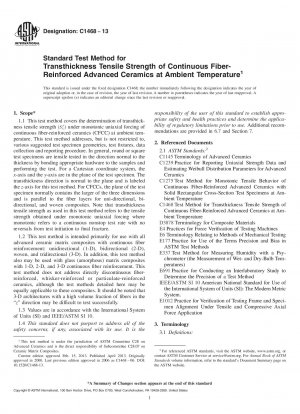ASTM C1468-13
Standard Test Method for Transthickness Tensile Strength of Continuous Fiber-Reinforced Advanced Ceramics at Ambient Temperature
- Standard No.
- ASTM C1468-13
- Release Date
- 2013
- Published By
- American Society for Testing and Materials (ASTM)
- Status
- Replace By
- ASTM C1468-19
- Latest
- ASTM C1468-19a
- Scope
4.1 This test method may be used for material development, material comparison, quality assurance, characterization, and design data generation.
4.2 Continuous fiber-reinforced ceramic matrix composites generally are characterized by fine grain sized (lt;50 μm) glass or ceramic matrices and ceramic fiber reinforcements. CFCCs are candidate materials for high-temperature structural applications requiring high degrees of corrosion and oxidation resistance, wear resistance, and inherent damage tolerance, that is, toughness. In addition, continuous fiber-reinforced glass (amorphous) matrix composites are candidate materials for similar but possibly less-demanding applications. Although shear test methods are used to evaluate shear interlaminar strength (τZX, τZY) in advanced ceramics, there is significant difficulty in test specimen machining and testing. Improperly prepared notches can produce nonuniform stress distribution in the shear test specimens and can lead to ambiguity of interpretation of strength results. In addition, these shear test specimens also rarely produce a gage section that is in a state of pure shear. Uniaxially-forced transthickness tensile strength tests measure the tensile interlaminar strength
 avoid the complications listed above, and provide information on mechanical behavior and strength for a uniformly stressed material. The ultimate strength value measured is not a direct measure of the matrix strength, but a combination of the strength of the matrix and the level of bonding between the fiber, fiber/matrix interphase, and the matrix.
avoid the complications listed above, and provide information on mechanical behavior and strength for a uniformly stressed material. The ultimate strength value measured is not a direct measure of the matrix strength, but a combination of the strength of the matrix and the level of bonding between the fiber, fiber/matrix interphase, and the matrix.4.3 CFCCs tested in a transthickness tensile test may fail from a single dominant flaw or from a cumulative damage process; therefore, the volume of material subjected to a uniform tensile stress for a single uniaxially-forceed transthickness tensile test may be a significant factor in determining the ultimate strength of CFCCs. The probabilistic nature of the strength distributions of the brittle matrices of CFCCs requires a sufficient number of test specimens at each testing condition for statistical analysis and design, with guidelines for test specimen size and sufficient numbers provided in this test method. Studies to determine the exact influence of test specimen volume on strength distributions for CFCCs have not been completed. It should be noted that strengths obtained using other recommended test specimens with different volumes and areas may vary due to these volume differences.
4.4 The results of transthickness tensile tests of test specimens fabricated to standardized dimensions from a particular material, or selected portions of a part, or both, may not totally represent the strength and deformation properties of the entire, full-size end product or its in-service behavior in different environments.
4.5 For quality control purposes, results derived from standardized transthickness tensile test specimens may be considered indicative of the response of the material from which they were taken for given primary processing conditions and post-processing heat treatments.
4.6 The strength of CFCCs is dependent on their inherent resistance to fracture, the presence of flaws, or damage accumulation processes, or a comb......
ASTM C1468-13 Referenced Document
- ASTM C1145 Standard Terminology of Advanced Ceramics
- ASTM C1239 Standard Practice for Reporting Uniaxial Strength Data and Estimating Weibull Distribution Parameters for Advanced Ceramics
- ASTM C1275 Standard Test Method for Monotonic Tensile Behavior of Continuous Fiber-Reinforced Advanced Ceramics with Solid Rectangular Cross-Section Test Specimens at Ambient Temperature*, 2024-04-20 Update
- ASTM D3878 Standard Terminology Composite Materials
- ASTM E1012 Standard Practice for Verification of Specimen Alignment Under Tensile Loading
- ASTM E177 Standard Practice for Use of the Terms Precision and Bias in ASTM Test Methods
- ASTM E337 Standard Test Method for Measuring Humidity with a Psychrometer (the Measurement of Wet- and Dry-Bulb Temperatures)
- ASTM E4 Standard Practices for Force Verification of Testing Machines
- ASTM E6 Standard Terminology Relating to Methods of Mechanical Testing
- ASTM E691 Standard Practice for Conducting an Interlaboratory Study to Determine the Precision of a Test Method
- IEEE/ASTM SI 10 American National Standard for Metric Practice
ASTM C1468-13 history
- 2019 ASTM C1468-19a Standard Test Method for Transthickness Tensile Strength of Continuous Fiber-Reinforced Advanced Ceramics at Ambient Temperature
- 2019 ASTM C1468-19 Standard Test Method for Transthickness Tensile Strength of Continuous Fiber-Reinforced Advanced Ceramics at Ambient Temperature
- 2013 ASTM C1468-13 Standard Test Method for Transthickness Tensile Strength of Continuous Fiber-Reinforced Advanced Ceramics at Ambient Temperature
- 2006 ASTM C1468-06 Standard Test Method for Transthickness Tensile Strength of Continuous Fiber-Reinforced Advanced Ceramics at Ambient Temperature
- 2000 ASTM C1468-00 Standard Test Method for Transthickness Tensile Strength of Continuous Fiber-Reinforced Advanced Ceramics at Ambient Temperature

Copyright ©2024 All Rights Reserved